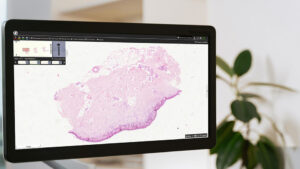Synopsis
Overcoming pathology problems in digital pathology workflow is crucial to ensure accurate and efficient work results. Though digital pathology has revolutionized the medical pathology practice, pathologists continue to face serious challenges. The key issues include quality and data management, complications around the integration of existing systems and workflows, and last but not least, problems with regulatory compliance. The laboratory or medical organization must pay attention to and manage critical aspects of its digital pathology workflow. These pathology problems need to be addressed individually to ensure that the results are as efficient as possible.
Challenges in Pathology
Digitization of workflows in the field of pathology helps to overcome major pathology problems. The digital movement has revolutionized the traditional way of working and made routine and day-to-day processes and activities easier and more accurate. However, it has also brought some pathology problems and challenges that need to be addressed and overcome as much as possible to reap benefits from this growing trend. Overcoming these challenges requires an individual approach to cover them more comprehensively and accurately. We will now discuss the five major problems in pathology that need special mention to make digital pathology workflows more effective.
1. Quality
It is crucial to ensure that the digital images obtained in the digital pathology processes are of high quality which primarily means the results are accurate and consistent. However, achieving it can sometimes be a challenge. Lighting, focus, and resolution are some of the challenges in histopathology and are the main factors that can affect the quality of the digital image. To overcome this drawback, a laboratory or a medical organization needs to meet certain quality control procedures, or in other words, regular image calibration and quality assurance reviews of the images. It is also advised to have automated quality control processes with the help of AI algorithms for image analysis and quality control.
2. Data Management
Digital pathology systems calibrate large amounts of data. These images can be obtained from standard to varying-size slides. If the laboratory or medical organization doesn’t pay attention to data management, storing, managing, and analyzing these images can be quite difficult. The data needs to be properly backed up and protected to ensure that it is not lost in case of system failures or other technical or manual errors. The best solution to overcome this challenge and avoid major pathological problems is to have a robust IT structure that will be useful in storing, managing, and analyzing a large amount of data. It is also recommended to have a data management plan consisting of detailed directions on how the data will be stored, managed, and analyzed, which will make the whole process easier.
3. Integration with Existing Systems
The digital pathology systems must be seamlessly integrated with the existing systems in the laboratory and IT infrastructure. This includes electronic medical records; pathology, laboratory, and hospital information systems; archiving and communication systems; and other systems used by the pathology laboratory. Without proper integration, digital pathology systems can become a bottleneck in the pathology workflow, slowing down the process and increasing the risk of errors. This challenge can be overcome only if all the involved systems are integrated into the medical and research digital pathology system.
4. Workflow Integration
Workflow integration is one of the major problems in pathology. Digital pathology systems need to be integrated into the existing pathology workflow processes. This includes integrating the systems into the processes used by pathologists, laboratory technicians, and other members of the medical research team. This can be challenging primarily because it requires changing the way pathology is practiced and sometimes even retraining the medical staff. All stakeholders in the pathology system need to be involved in these processes. Only in that way, it is possible to maximize the benefits and minimize the risks of digitization. In this case, it is also useful for pathology informatics. This system can be especially helpful when it comes to designing a new workflow that will include a digital pathology system.
5. Regulatory Compliance
Digital pathology problems and challenges also include issues around regulatory compliance. Digital pathology systems need to comply with various regulatory requirements, like HIPAA and CLIA to ensure patient data is protected and that the systems are used for diagnostic purposes. This also involves data security, and that the patient data is used only by qualified staff. Regulatory compliance is even a way to ensure accuracy and dependability while meeting regulatory bodies’ standards. Strict security measures are necessary to protect patient data and ensure that the system is only used by qualified personnel. To conform to all these regulatory compliance standards, for example, set by HIPAA and CLIA are met, it is also necessary to set up a periodic, optimized evaluation that will ensure accuracy and reliability.
Catania’s Canizzaro Hospital Overcame Digital Pathology Problems
A hospital in Catania, Italy, has successfully overcome some of the challenges associated with pathology digitization. The hospital successfully implemented whole slide imaging (WSI) for routine clinical practice; one of the rare examples on a global level. All (100%) permanent histopathology glass slides were digitized. Compatible stain and scanning slide racks were employed to streamline operations.
Enhancing Slide Management with Bi-Directional Software Integration
A slide manager software was used that was bi-directionally interfaced with the anatomic pathology laboratory information systems. Virtual slide trays were connected to the 2D barcode tracking system. It allows you to confirm that they were correctly assigned slides and that all tissues on the glass slides were scanned. Over 115,000 glass slides were digitalized. Drying glass slides before scanning minimized the sticking to scanner racks. Implementation required the introduction of a 2D barcode tracking system and modification of histology work processes.
Optimizing Workflow and IT Integration for Effective WSI Adoption
Effective adoption of WSI for primary diagnostic use was more dependent on optimizing pre-imaging variables and integration with laboratory information systems than on information technology infrastructure. Implementation of digital pathology for routine practice not only leveraged the benefits of digital imaging but also created an opportunity for establishing standardization of workflow processes in the pathology laboratory.
Conclusion
The digitization of pathology workflows brings much potential to pathology practice but also poses several obstacles that need to be addressed. Data management, quality control, integration with existing systems, workflow integration, and managing the regulatory aspect are major challenges that pathologists face today in their digitized workflow. To overcome these challenges, medical institutions and laboratories must pay attention to the proper implementation of digital pathology workflows to maximize the benefits and minimize the risks that digitization brings.
A comprehensive approach is crucial. All stakeholders in the workflow need to be integrated into the workflow because every aspect of the process, from quality control to security and legal aspects, needs to function properly to ensure maximum benefits and avoidance of possible risks. PreciPoint offers products and services that address all these challenges and makes the digitization of existing processes smooth and fast.











